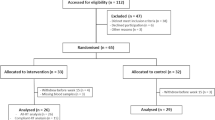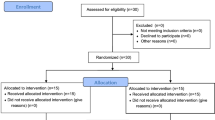Abstract
Background:
Overweight individuals commonly demonstrate elevated levels of inflammatory and cell adhesion molecules. Elevated levels of inflammation and adhesion have been implicated in the pathogenesis of cardiovascular disease. Aerobic exercise has been shown to be effective in altering specific biomarkers of inflammation and cell adhesion; however, little is known regarding the effects of resistance training (RT) on these biomarkers. This study examined the effects of 1 year of moderate-intensity RT on biomarkers of inflammation and adhesion in healthy, overweight women.
Methods and Results:
Participants included 28 (12 control, 16 RT) overweight (body mass index⩾25 kg/m2) women, aged 25–44 years, studied before and after 1 year of RT. C-reactive protein (CRP), interleukin-6 (IL-6), adiponectin, intracellular adhesion molecule-1, vascular cell adhesion molecule-1 and E-selectin were measured by standard enzyme-linked immunosorbent assays. Body composition, blood pressure, fasting blood lipids, glucose and insulin also were assessed. There were no significant changes in blood pressure, fasting blood lipids, glucose or insulin levels in either group after 1 year. There was also no change in body mass or fat mass in either group; however, there was a significant increase in lean body mass (P<0.05) in the RT group. Both CRP (P<0.01) and adiponectin (P<0.01) demonstrated significant improvements in the RT group, with no change in IL-6. Conversely, there were no associated changes in the biomarkers of cell adhesion in either group.
Conclusions:
This study demonstrates that moderate-intensity RT significantly results in modest improvements of inflammatory markers without affecting cell adhesion molecules in overweight women.
This is a preview of subscription content, access via your institution
Access options
Subscribe to this journal
Receive 12 print issues and online access
$259.00 per year
only $21.58 per issue
Buy this article
- Purchase on Springer Link
- Instant access to full article PDF
Prices may be subject to local taxes which are calculated during checkout

Similar content being viewed by others
References
##National Task Force on the Prevention and Treatment of Obesity: overweight, obesity, and health risk. Arch Intern Med 2000; 160: 898–904.
Lamarche B . Abdominal obesity and its metabolic complications: implications for the risk of ischaemic heart disease. Coronary Artery Dis 1998; 9: 473–481.
Stunkard AJ . The current status of treatment for obesity in adults. Res Publ Assoc Res Nerv Ment Dis 1984; 62: 157–173.
Reaven GM . Role of insulin resistance in human disease (syndrome X): an expanded definition. Annu Rev Med 1993; 44: 121–131.
Grundy SM . Primary prevention of coronary heart disease: integrating risk assessment with intervention. Circulation 1999; 100: 988–998.
Leon AS, Norstrom J . Evidence of the role of physical activity and cardiorespiratory fitness in the prevention of coronary heart disease. Quest 1995; 47: 311–319.
Thompson PD . Exercise and physical activity in the prevention and treatment of atherosclerotic cardiovascular disease. Arterioscler Thromb Vasc Biol 2003; 23: 1319–1321.
American College of Sports Medicine Position Stand. The recommended quantity and quality of exercise for developing and maintaining cardiorespiratory and muscular fitness, and flexibility in healthy adults. Med Sci Sports Exerc 1998; 30: 975–991.
Kraemer WJ, Adams K, Cafarelli E, Dudley GA, Dooly C, Feigenbaum MS et al. American College of Sports Medicine position stand. Progression models in resistance training for healthy adults. Med Sci Sports Exerc 2002; 34: 364–380.
Arita Y, Kihara S, Ouchi N, Takahashi M, Maeda K, Miyagawa J et al. Paradoxical decrease of an adipose-specific protein, adiponectin, in obesity. Biochem Biophys Res Commun 1999; 257: 79–83.
Visser M, Bouter LM, McQuillan GM, Wener MH, Harris TB . Elevated C-reactive protein levels in overweight and obese adults. JAMA 1999; 282: 2131–2135.
Yudkin JS, Stehouwer CD, Emeis JJ, Coppack SW . C-reactive protein in healthy subjects: associations with obesity, insulin resistance, and endothelial dysfunction: a potential role for cytokines originating from adipose tissue? Arterioscler Thromb Vasc Biol 1999; 19: 972–978.
Escobar-Morreale HF, Villuendas G, Botella-Carretero JI, Sancho J, San Millan JL . Obesity, and not insulin resistance, is the major determinant of serum inflammatory cardiovascular risk markers in pre-menopausal women. Diabetologia 2003; 46: 625–633.
Heinrich PC, Castell JV, Andus T . Interleukin-6 and the acute phase response. Biochem J 1990; 265: 621–636.
Blake GJ, Ridker PM . Inflammatory bio-markers and cardiovascular risk prediction. J Intern Med 2002; 252: 283–294.
Ridker PM . Novel risk factors and markers for coronary disease. Adv Intern Med 2000; 45: 391–418.
Dong ZM, Wagner DD . Leukocyte–endothelium adhesion molecules in atherosclerosis. J Lab Clin Med 1998; 132: 369–375.
Pasceri V, Willerson JT, Yeh ET . Direct proinflammatory effect of C-reactive protein on human endothelial cells. Circulation 2000; 102: 2165–2168.
Hwang SJ, Ballantyne CM, Sharrett AR, Smith LC, Davis CE, Gotto Jr AM et al. Circulating adhesion molecules VCAM-1, ICAM-1, and E-selectin in carotid atherosclerosis and incident coronary heart disease cases: the Atherosclerosis Risk in Communities (ARIC) study. Circulation 1997; 96: 4219–4225.
Guray U, Erbay AR, Guray Y, Yilmaz MB, Boyaci AA, Sasmaz H et al. Levels of soluble adhesion molecules in various clinical presentations of coronary atherosclerosis. Int J Cardiol 2004; 96: 235–240.
Cybulsky MI, Iiyama K, Li H, Zhu S, Chen M, Iiyama M et al. A major role for VCAM-1, but not ICAM-1, in early atherosclerosis. J Clin Invest 2001; 107: 1255–1262.
Arita Y, Kihara S, Ouchi N, Takahashi M, Maeda K, Miyagawa J-I et al. Paradoxical decrease of an adipose-specific protein, adiponectin, in obesity. Biochem Biophys Res Commun 1999; 257: 79–83.
Ouchi N, Kihara S, Funahashi T, Matsuzawa Y, Walsh K . Obesity, adiponectin and vascular inflammatory disease. Curr Opin Lipidol 2003; 14: 561–566.
Flegal KM, Carroll MD, Ogden CL, Johnson CL . Prevalence and trends in obesity among US adults, 1999–2000. JAMA 2002; 288: 1723–1727.
Rifai N, Buring JE, Lee IM, Manson JE, Ridker PM . Is C-reactive protein specific for vascular disease in women? Ann Intern Med 2002; 136: 529–533.
Blum C, Muller B, Huber P, Kraenzlin M, Schindler C, De Geyter C . Low-grade inflammation and estimates of insulin resistance during the menstrual cycle in lean and overweight women. J Clin Endocrinol Metab 2005; 90: 3230–3235.
Matthews DR, Hosker JP, Rudenski AS, Naylor BA, Treacher DF, Turner RC . Homeostasis model assessment: insulin resistance and beta-cell function from fasting plasma glucose and insulin concentrations in man. Diabetologia 1985; 28: 412–419.
Fleck SJ, Kraemer WJ . Designing Resistance Training Programs, 2nd edn. Human Kinetics: Champaogn, IL, 1997.
Ross R . Atherosclerosis – an inflammatory disease. N Engl J Med 1999; 340: 115–126.
Bruunsgaard H, Galbo H, Halkjaer-Kristensen J, Johansen TL, MacLean DA, Pedersen BK . Exercise-induced increase in serum interleukin-6 in humans is related to muscle damage. J Physiol 1997; 499 (Part 3): 833–841.
Tisi PV, Shearman CP . Biochemical and inflammatory changes in the exercising claudicant. Vasc Med 1998; 3: 189–198.
Mattusch F, Dufaux B, Heine O, Mertens I, Rost R . Reduction of the plasma concentration of C-reactive protein following nine months of endurance training. Int J Sports Med 2000; 21: 21–24.
Thomas SJ, Cooney TE, Thomas DJ . Comparison of exertional indices following moderate training in collegiate athletes. J Sports Med Phys Fitness 2000; 40: 156–161.
Church TS, Barlow CE, Earnest CP, Kampert JB, Priest EL, Blair SN . Associations between cardiorespiratory fitness and C-reactive protein in men. Arterioscler Thromb Vasc Biol 2002; 22: 1869–1876.
Pischon T, Hankinson SE, Hotamisligil GS, Rifai N, Rimm EB . Leisure-time physical activity and reduced plasma levels of obesity-related inflammatory markers. Obes Res 2003; 11: 1055–1064.
Rothenbacher D, Hoffmeister A, Brenner H, Koenig W . Physical activity, coronary heart disease, and inflammatory response. Arch Intern Med 2003; 163: 1200–1205.
Hulver MW, Zheng D, Tanner CJ, Houmard JA, Kraus WE, Slentz CA et al. Adiponectin is not altered with exercise training despite enhanced insulin action. Am J Physiol Endocrinol Metab 2002; 283: E861–E865.
Marcell TJ, McAuley KA, Traustadottir T, Reaven PD . Exercise training is not associated with improved levels of C-reactive protein or adiponectin. Metabolism 2005; 54: 533–541.
Esposito K, Pontillo A, Di Palo C, Giugliano G, Masella M, Marfella R et al. Effect of weight loss and lifestyle changes on vascular inflammatory markers in obese women: a randomized trial. JAMA 2003; 289: 1799–1804.
Brekke HK, Lenner RA, Taskinen MR, Mansson JE, Funahashi T, Matsuzawa Y et al. Lifestyle modification improves risk factors in type 2 diabetes relatives. Diabetes Res Clin Pract 2005; 68: 18–28.
Jurimae J, Purge P, Jurimae T . Adiponectin is altered after maximal exercise in highly trained male rowers. Eur J Appl Physiol 2005; 93: 502–505.
Kriketos AD, Gan SK, Poynten AM, Furler SM, Chisholm DJ, Campbell LV . Exercise increases adiponectin levels and insulin sensitivity in humans. Diabetes Care 2004; 27: 629–630.
Hotta K, Funahashi T, Arita Y, Takahashi M, Matsuda M, Okamoto Y et al. Plasma concentrations of a novel, adipose-specific protein, adiponectin, in type 2 diabetic patients. Arterioscler Thromb Vasc Biol 2000; 20: 1595–1599.
Havel PJ . Peripheral signals conveying metabolic information to the brain: short-term and long-term regulation of food intake and energy homeostasis. Exp Biol Med (Maywood) 2001; 226: 963–977.
Yang AL, Chen HI . Chronic exercise reduces adhesion molecules/iNOS expression and partially reverses vascular responsiveness in hypercholesterolemic rabbit aortae. Atherosclerosis 2003; 169: 11–17.
Arosio E, Minuz P, Prior M, Zuliani V, Gaino S, De Marchi S et al. Vascular adhesion molecule-1 and markers of platelet function before and after a treatment with iloprost or a supervised physical exercise program in patients with peripheral arterial disease. Life Sci 2001; 69: 421–433.
Wegge JK, Roberts CK, Ngo TH, Barnard RJ . Effect of diet and exercise intervention on inflammatory and adhesion molecules in postmenopausal women on hormone replacement therapy and at risk for coronary artery disease. Metabolism 2004; 53: 377–381.
Adamopoulos S, Parissis J, Kroupis C, Georgiadis M, Karatzas D, Karavolias G et al. Physical training reduces peripheral markers of inflammation in patients with chronic heart failure. Eur Heart J 2001; 22: 791–797.
Ouchi N, Kihara S, Arita Y, Maeda K, Kuriyama H, Okamoto Y et al. Novel modulator for endothelial adhesion molecules: adipocyte-derived plasma protein adiponectin. Circulation 1999; 100: 2473–2476.
Acknowledgements
This study was supported financially in part through grants from NIH Grant No. 5R01DK060743-03, American Heart Association Grant No. 0410034Z, and General Clinical Research Center Program, NCRR/NIH No. M01-RR00400.
Author information
Authors and Affiliations
Corresponding author
Additional information
Conflict of interest
The authors of this manuscript have no conflicts of interest.
Rights and permissions
About this article
Cite this article
Olson, T., Dengel, D., Leon, A. et al. Changes in inflammatory biomarkers following one-year of moderate resistance training in overweight women. Int J Obes 31, 996–1003 (2007). https://doi.org/10.1038/sj.ijo.0803534
Received:
Revised:
Accepted:
Published:
Issue Date:
DOI: https://doi.org/10.1038/sj.ijo.0803534
Keywords
This article is cited by
-
The effects of combined exercise training on glucose metabolism and inflammatory markers in sedentary adults: a systematic review and meta-analysis
Scientific Reports (2024)
-
Mechanisms for Combined Hypoxic Conditioning and Divergent Exercise Modes to Regulate Inflammation, Body Composition, Appetite, and Blood Glucose Homeostasis in Overweight and Obese Adults: A Narrative Review
Sports Medicine (2023)
-
Barriers and Facilitators to Muscle-Strengthening Activity Among Latinas in the U.S.: Results From Formative Research Assessments
International Journal of Behavioral Medicine (2023)
-
Comparative Effectiveness of Multiple Exercise Interventions in the Treatment of Mental Health Disorders: A Systematic Review and Network Meta-Analysis
Sports Medicine - Open (2022)
-
Exercise medicine for cancer cachexia: targeted exercise to counteract mechanisms and treatment side effects
Journal of Cancer Research and Clinical Oncology (2022)



